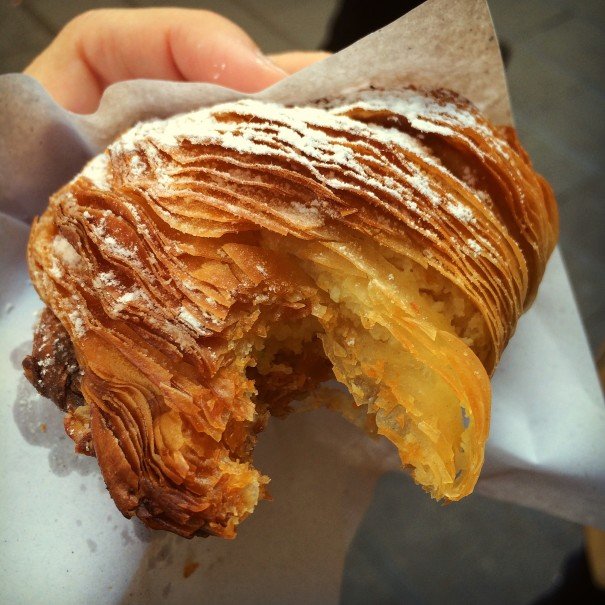
Eating a Messy Pastry on the Sidewalk in a City Where People Don’t Do That

Eating a Messy Pastry on the Sidewalk in a City Where People Don’t Do That
Sfoliatelle Riccia in Naples
When you approached the Pasticceria Pintauro onto Naples’s Via Toledo, you smelled the aroma of butter emanating from the tiny, table-less bakery from a block away. The pastries, shell-shaped flakes filled with a perfumed but not sweet mixture of orange-flavored almond paste and ricotta cheese, are now hot in their paper bag, sweating through parchment squares. Sfoliatelle riccia.
This is not New York; you can’t just strut down the street chewing with your mouth open like you’re John Travolta in Saturday Night Fever. People are already looking at you with curiosity as you stand uncertainly outside the shop, calculating how quickly you can get to an appropriately private place to commune with your breakfast against how long it will take for the crispy layers to turn cold and damp.
Let them look. For the traveller in Naples, there’s no better place to eat a Pintauro sfoliatella than on the sidewalk outside the shop, as classy Neopolitans brush by you in their puffy (yet strangely sleek) nylon jackets and well-cut suits on the pedestrian street where everyone is supposed to keep moving.
In today’s maze of borders, refugees, and “one in one out,” sfoliatelle is a thought experiment, as well as a pinnacle of Neopolitan confectionery. As the result of a melding of Arab, Greek, and Italian culinary traditions, it’s comforting—but slightly facile—to imagine the pastry as proof that in the past, people and ideas moved easily between various corners of the Mediterranean.
Much of what we think of today as Italian food comes from the Arab (also known as Saracen) sailors, engineers, and farmers that invaded and settled in Sicily and southern Italy beginning in the 9th century. Pasta wouldn’t have been invented without the hard, durable wheat developed and imported by the Arabs; the eggplant was once known in Italian as radice araba, or Arab root.
Sfoliatelle is undeniably an example of how Arab and Italian cooks blended their own traditions together to create something new. The almond, introduced to Italy by the Greeks, was first combined with sugar cane and used in confectionery by the Arabs. Saracen traders also brought citrus fruits like lemon and orange to European shores for the first time (the orange makes its first appearance in European records in 1002, as a gift to a Norman prince from an Arab).
But it wasn’t as sweet as “you’re new, let’s bake together.” Violence and religious persecution were hallmarks of the Saracen period in Italy. Some scholars think that many Arab-Italian sweets were developed and preserved by women of the Saracen harems banished to mountain convents after their courts were violently disbanded. Lucera, an Arab colony in Puglia, was founded after the Norman king Frederick II relocated Sicilian Arabs in response to religious riots. The town’s main cathedral now stands on the site of a mosque that was torn down during the Crusades (after all the Arab Muslims in town who refused to convert were massacred).
The news tells us that it hasn’t gotten any easier to assimilate, or welcome new people with open arms. Sometimes ideas clash violently. We can’t hope that groups of people, traumatized and fearful, will come together as smoothly as almond paste and ricotta. But we can challenge our ideas about difference while eating a messy pastry on the sidewalk in a city where people don’t do that.